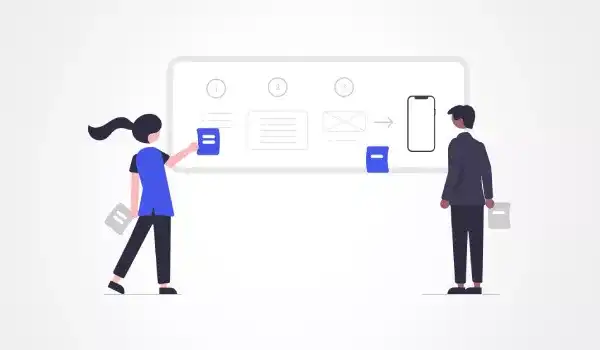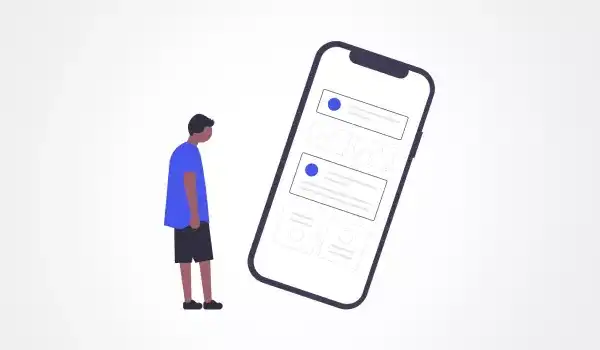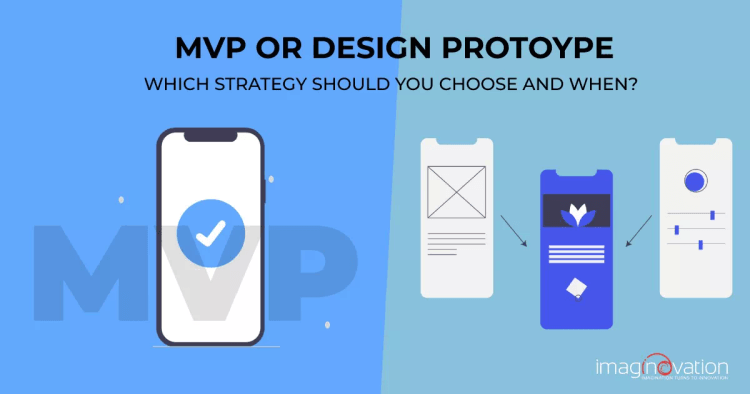Before you invest in digital product development, you have to validate your ideas and ensure a product-market fit. You can either create a design prototype or an MVP (Minimum Viable Product) to validate your ideas.
But, how to choose between these two options?
Selecting the right option will help you improve your chances of bringing down the overall product development costs, and building customer loyalty right from the initial stages of your app-building.
In this blog, we will be discussing the design prototype and MVP strategies. We will describe what they are, how they are different, and why and when you should use them.
Let’s start.
What is An App Prototype?
A mobile app prototype is a visual representation of the app. It shows how the app will flow from one screen to another and how it’d appear to the end-users.
It is essential that the design phase of the app development lifecycle must include a prototyping stage.
With app prototypes, users can explore and play with your app ideas and give you relevant feedback that shapes the final app designs before you get into its development.

Why Develop An App Prototype?
So, how does building an app prototype help your business? Here are some of the key benefits a design prototype can give to your business:
1. Exploring additional ideas & identifying product improvement
Mobile app prototyping validates an early concept and provides opportunities for exploring new ideas early on during the development process.
User testing during this phase can help you to discover possible improvements before the product is complete. Moreover, as the product foundation, a prototype must be improved continually until the mobile app meets business goals and is marketable.
2. User Experience and Design Validation
Building an app that guarantees strong user engagement is not easy. Prototyping is an effective way to do it by validating UX and app usability. A mere 32% of the users continue to use an app after three months of downloading it. At the same time, 21% of the users abandon an app after first use.
Businesses must go beyond the number of app downloads and work towards improving user retention. It happens with a great UX design – and this is where prototyping comes in handy. It tests the app’s potential for user engagement and longevity.
3. Fast Feedback
When testing prototypes, you can receive valuable feedback from live users. It allows you to recognize the app’s downsides quickly, fix them, and quickly move towards app development.
4. Improves cost-efficiency
Design prototyping of mobile apps saves cost in the long run. It is far less expensive to fix flaws and problems at the beginning of the process rather than towards the end.
Therefore, if you start testing on an “almost-final” app, you run the risk of finding serious issues, and it’ll be too late to make changes. The closer you get to the launch of your product, the more expensive changes will be.
So, conducting early and iterative prototyping prevents rework and avoids unnecessary expenses.
5. Client and Stakeholder Involvement
It’s best to involve all the crucial stakeholders in the design prototype process. Stakeholders must develop a co-ownership of the product’s design ideas and decisions.
Involving all the relevant stakeholders in the prototyping phase of a product creates a wider perspective, and you can be confident you’re making the most efficient use of your time.
In addition, stakeholders can help collect relevant information about the project’s strategic direction. Working with the right people helps ensure support and secures funding for the time and resources of app development.
What is an MVP?
Did you know the most popular and indispensable apps you use today did not begin their life as polished, expansive products?
They all began as something much simpler, as an MVP, and it took time and effort for them to mature into the slick app you now know and admire.
An MVP stands for Minimum Viable Product. It is a minimal form of your final product (an app, for example) that is tested in the market.
MVP is a strategy that builds a digital product by including only those features that you think are the most important for your product and those that need to be marketable.

Why Develop An MVP?
Let’s explore how an MVP is beneficial for your business.
1. Lower Cost
Since MVPs are products with minimum features, there is a cost reduction to its development. It is because the product is developed with only a few core features to solve a problem.
It thus needs less time to build it. This minimum approach is also used in ensuring that it is less complicated, which means less requirement for sophisticated coding and solutions. So when the product is simple, you can keep the costs low.
Besides, most mature products result from years of development, obviously with a price tag to match. But because these apps were built iteratively over a longer period, the price is spread over time, with reinvestment of the revenue generated from early versions.
2. Testing Business Concepts
Being able to test and validate their business concepts is the most significant benefit of building MVPs. When the organizations offer only the core set of features instead of a full-fledged, feature-heavy product, they can check and verify if their product concept resonates with their target audience.
If required, they can then change the product’s direction based on the findings. It is difficult to change much in a complete feature-heavy product because it means rebuilding the entire product.
Let’s take the example of Instagram when it launched as an MVP. Back then, it was not the photo-sharing app we know of today. Originally, Instagram’s design was centered around a GPS feature. However, after its launch, the company decided to change the concept based on feedback received.
3. Faster Product Release
The decision to build your app around only the core functionality significantly speeds up its release. After the release of your product’s first version, you can freely test key hypotheses quickly and collect users’ feedback.
Besides, procrastinating on the release date of your product can lead to developing unnecessary features and wasting time on costly bug fixes. You can go in for a quick release of an uncomplicated, clean and functional MVP.
4. Winning Stakeholder/Investor Buy-In
All businesses rely on stakeholder buy-in to secure funding for their projects. The key to receive this buy-in is to build confidence in the product.
MVP is an effective way to secure this buy-in as it allows businesses to evaluate if their idea will work before putting it in front of investors.
Moreover, an MVP is a fully functioning product, so businesses can showcase a physical product that can be launched into the market without waiting for months to see the ROI.
5. Making room for product evolution
The benefits of building an MVP continue into the later stages of your product development.
It happens because feature stuffing is prevented early in the development process, and it creates room for updates and new features that customers may ask for later.
Moreover, since your MVP makes the growth of your product gradual, your product can benefit from the latest technology when it becomes available.
Updating your product by integrating added features and newer technology while keeping the core function in mind helps you keep your product relevant in a competitive business world.
6. Verifying market demand
An MVP is majorly about testing – assessing what works and what doesn’t. Many organizations assume that the product they’re building fulfills the market demand; however, this may not be true as either the need doesn’t exist or solutions available in the market already address the pain point.
An MVP allows organizations to test and verify the market demand for their product. It checks if potential users will use the product. Based on the findings, organizations can either rework the solution or develop a new concept altogether.
What is the difference between MVP and Prototype?
Now that you know what is a design prototype and MVP, you might be wondering what makes them different? Let’s see how an MVP is different from a design prototype.

1. Utilized at different product development stages
Prototypes are typically built at the early stages of product development for presentations and user testing. After the prototype validation, its lifetime ends.
The feedback that you get from early users is applicable here. If the feedback is negative, you can alter the prototype and try again.
You can conclude the results obtained from the prototype if the feedback is positive.
MVP development begins after this.
Here, you can turn to a different product development system – from sketch coding to product development that the first users will see.
2. Scope
The scope of a prototype and an MVP is quite different. A prototype is built with very little time and effort. Companies usually come up with a variety of prototypes to change, adapt, and discard unnecessary ideas quickly.
With an MVP, you pick an idea and start development.
3. Commitment
After investing time and resources into an MVP, there are fewer chances of completely scrapping it and starting from scratch.
However, with a design prototype, it can be as simple as crumpling up the paper and starting there and then.
4. Audiences
The intended audiences of Prototypes and MVPs are not the same. Prototypes are primarily built for internal teams. At most, you’ll consider giving them to the press for creating a buzz or use them for crowdfunding purposes. But they’re never built for the target market.
An MVP is intended to be launched to your target market to evaluate its reception. An MVP is considered for the next version of release.
5. Investors and Stakeholders buy-in
When persuading your investors that a specific idea is worth investment, the prototype is only a sketch and not a fully functional product. In comparison, the minimum viable product is a fully functional product with bare minimum features.
So, what should you choose for your business idea validation – minimum viable product or prototype?
While the question does not have a straightforward answer, let’s read on to know when to choose which approach.
When to choose an MVP?
You must go in for a minimum viable product strategy when you’re sure about its technical possibilities, design and want to launch it to the market.
An MVP isn’t a mature product, but it’s considered the final step toward its development. You can consider implementing this approach in the following scenarios:
- You want to explore the market’s perception and find out if your product will be received well and stay in demand so that it can be improvised timely.
- You want to save cost and time developing the product with only the essential features.
- You need immediate user feedback on a working app, and it can prepare the base for further improvements.
- You need to map a development way to mitigate the risk of product failure.
- When you expect higher retention at a low cost.
When to choose a prototype?
You can opt to go in for prototyping when you’re confident in your idea’s feasibility and now wish to test the product design concept.
You can consider prototyping in the following cases:
- When you want to visualize how your product will look and function.
- When you have limited time and money, but you want to showcase your product to stakeholders and investors.
- You wish to design a product with fantastic user flow and user experience.
- When there is minimal tech availability, but you want to see how the product will look like.
Develop Stunning Digital Products with Imaginovation
As you can see, the prototyping and MVP strategies can both be used in product development. The reasons to use them differently, and they’re applied at different stages of product development. And they are certainly not interchangeable.
Whether you wish to validate your idea and build a design prototype or an MVP, we at Imaginovation can help you make the right choice and proceed in your quest for creating a stunning digital product.
We are an award-winning web and mobile app development agency with vast experience in crafting remarkable digital success stories for diverse companies. Let’s talk.




